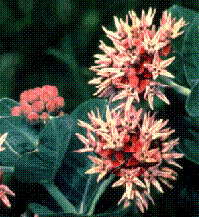
Showy Milkweed (Asclepias speciosa)
A native North Dakotan with statewide distribution, showy milkweed also occupies prairies and openings from Minnesota to British Columbia south to Missouri, New Mexico, and California, at elevations up to 7,500 ft.
Showy milkweed is a coarse perennial up to four feet tall. The light-green leaves are oval to nearly round, opposite each other, and may be over six inches long. About ten to twenty flowers grow in a cluster from white-wooly stalks radiating from a central point. Flower structure is very confusing in milkweeds, because the regular floral parts (greenish sepals and purplish petals) bend strongly downward, exposing a large, complex crown of male appendages consisting, among other things, of long tan hoods with incurved horns.
These plants are most apt to be found in idle or lightly grazed grassland in our area. Cattle avoid milkweeds because of the bitter latex contained in the stems and leaves. Milkweeds are known to be toxic to livestock and domestic fowl, but usually under conditions of forced ingestion of large quantities through mismanagement or drought. Boiled buds and young leaves of showy milkweed were eaten by several tribes of Amerindians, and some used the dried latex as chewing gum. Many milkweeds were formerly used medicinally, and included in pharmacopoeias in many parts of the world.
Some readers will remember collecting pods (called follicles) of showy and common milkweed (A. syriaca) during the World War II effort. These pods were filled with seeds bearing long silky hairs that were used as filler for aviation life jackets.
The name of the milkweed family (Asclepiadaceae) and the generic name was dedicated to Asklepios, the Greek god of medicine. The specific name speciosa means "showy" in botanical Latin. Showy milkweed was described for science in 1828 by the eminent botanist-chemist-physician at Columbia, John Torrey (1796-1875).
![]()
 Wildflower
Seed For Sale
Wildflower
Seed For Sale